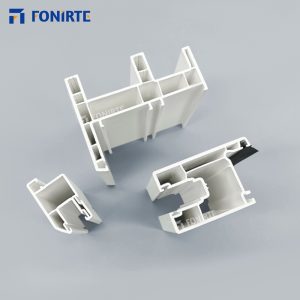
⚡ The Welding Process Demystified
The welding of UPVC profiles involves a precisely controlled thermal process where specialized welding machines heat the profile ends to approximately 240-250°C. This optimal temperature range melts the UPVC profiles surfaces without causing material degradation. The heated UPVC profiles are then immediately pressed together with precisely calculated pressure, typically between 3-5 bar, creating molecular fusion at the joint. The entire welding cycle for UPVC profiles takes approximately 30-45 seconds, including heating, joining, and cooling phases. Modern welding equipment for UPVC profiles features digital temperature controls and automated pressure systems, ensuring consistent results across all production batches. The welded corners of UPVC profiles achieve up to 80% of the base material’s strength, creating joints that withstand significant structural loads and environmental stresses.
🎯 Quality Indicators and Performance Standards
High-quality welded joints in UPVC profiles exhibit clean, virtually invisible seams with minimal external bead formation. The welding strength of UPVC profiles must meet rigorous international standards, typically requiring welded corners to withstand tensile forces exceeding 3500 Newtons. Premium UPVC profiles maintain perfect 90-degree angles after welding, with dimensional accuracy within ±0.5mm. The welding quality of UPVC profiles directly impacts their long-term performance, affecting everything from weather tightness to operational smoothness. Professional manufacturers of UPVC profiles conduct regular destructive testing on sample welds to verify joint integrity, ensuring that every production batch maintains the highest quality standards. The excellent weldability of modern UPVC profiles stems from their optimized material formulation, which includes precisely balanced thermal stabilizers and impact modifiers.
🌟 Advantages in Real-World Applications
The welding technology used for UPVC profiles creates numerous advantages in practical applications. Welded corners in UPVC profiles provide superior structural stability compared to mechanical connections, eliminating loose joints and maintaining perfect geometry over time. The seamless nature of welded UPVC profiles prevents water infiltration and air leakage, significantly enhancing the energy efficiency of window systems. This joining method allows UPVC profiles to withstand extreme weather conditions, including hurricane-force winds and temperature variations from -40°C to 70°C. The precision achievable through modern welding techniques enables manufacturers to create complex geometric shapes from UPVC profiles, supporting innovative architectural designs while maintaining exceptional performance standards. The reliability of welded UPVC profiles has been proven through decades of successful installations across diverse climate zones worldwide.
Choose professionally welded UPVC profiles—where perfect joints create lasting performance and unmatched reliability. 🏗️✨






